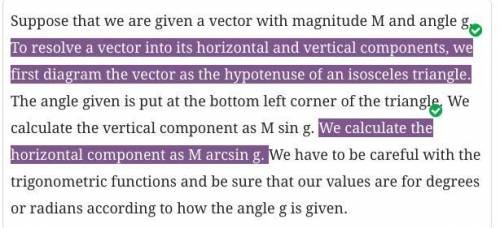
Physics, 16.02.2021 22:00, johnkings140
You are rereading your notes from class about resolving vectors, but some parts are not making sense. It is apparent that there are some mistakes in your notes. Select all the mistakes.
1.Suppose that we are given a vector with magnitude M and angle g.
2.To resolve a vector into its horizontal and vertical components, we first diagram the vector as the hypotenuse of an isosceles triangle.
3.The angle given is put at the bottom left corner of the triangle.
4. We calculate the vertical component as M sin g. We calculate the horizontal component as M arcsin g.
5.We have to be careful with the trigonometric functions and be sure that our values are for degrees or radians according to how the angle g is given.

Answers: 3
Other questions on the subject: Physics

Physics, 22.06.2019 09:00, cmflores3245
Sobre transformações cíclicas, são feitas algumas afirmações, determine quais estão corretas. i – a variação de energia interna em uma transformação cíclica é nula; ii – o trabalho, em uma transformação cíclica, é sempre positivo; iii – ao completar um ciclo, o gás tem a mesma temperatura com a qual começou a transformação; iv – uma transformação cíclica é, obrigatoriamente, composta de transformações conhecidas, como adiabática, isocórica, etc: a) i e iii b) i e ii c) ii e iii d) i e iv e) iii e iv
Answers: 1


Physics, 22.06.2019 16:40, Crxymia
Aparticle's position is given by x = 3.00 - 9.00t + 3t2, in which x is in meters and t is in seconds. (a) what is its velocity at t = 1 s? (b) is it moving in the positive or negative direction of x just then? (c) what is its speed just then? (d) is the speed increasing or decreasing just then? (try answering the next two questions without further calculation.) (e) is there ever an instant when the velocity is zero? if so, give the time t; if not, answer "0". (f) is there a time after t = 3 s when the particle is moving in the negative direction of x? if so, give the time t; if not, answer "0".
Answers: 3

Physics, 23.06.2019 02:10, eddiecas
The average atmospheric pressure on earth is approximated as a function of altitude by the relation patm = 101.325 (1 − 0.02256z)5.256, where patm is the atmospheric pressure in kpa, and z is the altitude in km with z = 0 at sea level. determine the approximate atmospheric pressures at atlanta (z = 306 m), denver (z = 1610 m), mexico city (z = 2309 m), and the top of mount everest (z = 8848 m).
Answers: 3
Do you know the correct answer?
You are rereading your notes from class about resolving vectors, but some parts are not making sense...
Questions in other subjects:






Mathematics, 06.05.2020 23:14

Social Studies, 06.05.2020 23:14









